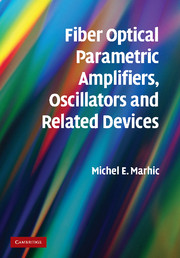Book contents
- Frontmatter
- Contents
- Acknowledgments
- 1 Introduction
- 2 Properties of single-mode optical fibers
- 3 Scalar OPA theory
- 4 Vector OPA theory
- 5 The optical gain spectrum
- 6 The nonlinear Schrödinger equation
- 7 Pulsed-pump OPAs
- 8 OPO theory
- 9 Quantum noise figure of fiber OPAs
- 10 Pump requirements
- 11 Performance results
- 12 Potential applications of fiber OPAs and OPOs
- 13 Nonlinear crosstalk in fiber OPAs
- 14 Distributed parametric amplification
- 15 Prospects for future developments
- Appendices
- Index
- References
12 - Potential applications of fiber OPAs and OPOs
Published online by Cambridge University Press: 23 March 2010
- Frontmatter
- Contents
- Acknowledgments
- 1 Introduction
- 2 Properties of single-mode optical fibers
- 3 Scalar OPA theory
- 4 Vector OPA theory
- 5 The optical gain spectrum
- 6 The nonlinear Schrödinger equation
- 7 Pulsed-pump OPAs
- 8 OPO theory
- 9 Quantum noise figure of fiber OPAs
- 10 Pump requirements
- 11 Performance results
- 12 Potential applications of fiber OPAs and OPOs
- 13 Nonlinear crosstalk in fiber OPAs
- 14 Distributed parametric amplification
- 15 Prospects for future developments
- Appendices
- Index
- References
Summary
Introduction
The potential for fiber OPAs and OPOs is based on some characteristic features that are not present in other types of optical amplifiers and oscillators. Specifically, the features that can be exploited are: (i) the availability of gain at essentially arbitrary wavelengths, limited only by the availability of the necessary pumps and of fibers with suitable nonlinearity, loss, and dispersion; (ii) the availability of an idler; (iii) the nearly instantaneous response of the gain to pump power variations; (iv) the all-fiber structure, which is capable of withstanding high powers.
In this chapter we will discuss the main applications that can be envisioned and describe the experiments that have been performed in some areas. For OPAs, the main areas of applications that have been envisioned so far are in optical communication and high-power wavelength conversion. We now discuss each of these areas in some depth.
OPAs in optical communication
This is the most advanced area, in part because of the availability of convenient fibers and pumps, developed for conventional communication systems. These have been exploited in recent years to demonstrate several applications of OPAs, naturally at wavelengths of interest for optical communication.
Amplification
The realization that fiber OPAs could exhibit gain bandwidths as large as or larger than those of erbium-doped fiber amplifiers (EDFAs), by the use of commercially available fibers and the watt-level pump powers that are now considered reasonable, sparked interest in their possible use in communication systems.
- Type
- Chapter
- Information
- Publisher: Cambridge University PressPrint publication year: 2007



